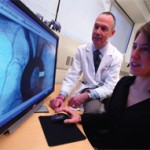NEW YORK (Reuters Health)—Authors should agree to share deidentified patient data as a condition for publication of a clinical trial report, according to a proposal from the International Committee of Medical Journal Editors (ICMJE). “Our patients generously and selflessly volunteer to participate in clinical trials on the promise that the knowledge gained will be used…
VA Musculoskeletal Education Pilot Program Helps PCPs Treat Patients
To improve access to quality of care for patients with osteoarthritis and other musculoskeletal pain, the U.S. Department of Veterans Affairs (VA) launched a continuing education program designed to strengthen the musculoskeletal knowledge and skills of primary care providers (PCPs). In the program’s initial trial in 2012, 19 physicians were trained on exams, treatments and joint injections. Two years after course completion, some participants increased the number of intraarticular corticosteroid injections at their clinics without needing to refer patients to specialists…

Rheumatology Researchers Explore Role of Neutrophils in Autoimmunity
SAN FRANCISCO—To unravel the mysteries of how autoimmunity begins in the body and, one day, to interrupt that process, rheumatology researchers are exploring the role of neutrophils, especially when they form and release neutrophil extracellular traps (NETs). At a panel discussion on Nov. 6, 2015, held at the American College of Rheumatology’s Basic Research Conference,…

Pattern Recognition Key to Fibrosing Lung Disease Diagnosis
SAN FRANCISCO—“Interstitial lung disease is the last bastion of great medicine,” according to Paul Noble, MD, chair, Department of Medicine, director, Women’s Guild Lung Institute, Vera and Paul Guerin Distinguished Chair in Pulmonary Medicine, Cedars-Sinai Medical Center, Los Angeles. Making it great medicine, he said, are the many things still unknown about this disease. In…

Search for Infectious Triggers of Rheumatic Disease Could Yield Options to Block Process
SAN FRANCISCO—Two hundred years ago, physicians knew nothing about what caused various forms of arthritis. Today, we have more clues about what may trigger rheumatic diseases, but still can’t pinpoint the culprits that set scores of inflammatory conditions in motion. Researchers discussed some of the background and recent findings that point to what immunologists call…

Rheumatic Disease Manifestations in the Central Nervous System
SAN FRANCISCO—Let’s say your radiologist comes to you and says that an angiogram gives a diagnosis of CNS vasculitis on four patients, all with acute onset of headache and stroke: One is a 25-year-old woman who is three months pregnant. Another is a 50-year-old man using excessive doses of nasal decongestants. Another is a 40-year-old…

Rheumatology Research Foundation Launches Honorary Board of Advisors
Nearly 150 of the Rheumatology Research Foundation’s most generous supporters gathered in November during the 2015 ACR/ARHP Annual Meeting for the Donors of Merit recognition event. In celebration of the Foundation’s 30th Anniversary in 2015, the event reflected on the journey to advance treatments and improve patient care. The Foundation’s president, David Karp, MD, PhD,…
Living with RA: Study Examines the Value of Patient Involvement in Creating Clinical Practice Guidelines
“The lived experience with RA is itself a valuable form of expertise,” writes Dr. Liana Fraenkel, MD, MPH, and her colleagues in their latest research. To examine the value of this expertise and how it can be incorporated into clinical practice guidelines, researchers developed 18 questions for which two panels—one physician dominated and one comprising entirely patients—would develop recommendations. For a majority of these questions, the patient panel made the same recommendations as the physician panel, with similar recommendation strengths…
Rheumatology Research Foundation’s Partnership with CRT Allows for Investment in Research, Training
The Rheumatology Research Foundation has infused more than $130 million into rheumatology research, education and training since it was established in 1985. The Foundation’s efforts have been greatly enhanced by the support of Corporate Roundtable (CRT) members. The CRT is a dynamic partnership between the Foundation and members of the pharmaceutical industry committed to furthering…

Rheumatology Research Foundation’s Incoming President Shares Vision for Building the Next 30 Years of Growth
Meet the Foundation’s incoming president, Eric L. Matteson, MD, MPH. Dr. Matteson trained in rheumatology at the University of Michigan and Mayo Graduate School of Medicine, Mayo Clinic College of Medicine. He later earned his Master of Public Health in epidemiology at the University of North Carolina, Chapel Hill. Dr. Matteson currently works as the…
- « Previous Page
- 1
- …
- 66
- 67
- 68
- 69
- 70
- …
- 129
- Next Page »